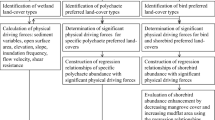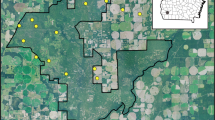Abstract
Alkaline wetland beaches provide crucial habitat for breeding piping plovers (Charadrius melodus) in the northern Great Plains of the United States and Canada. Vegetation encroachment has been identified as a potential threat that decreases alkaline beach habitat availability, but the long-term status of these breeding habitats has not been evaluated. We measured vegetation changes at two North Dakota alkaline wetland complexes from 1938 to 1997. Total beach habitat, including lower beaches that were impacted by flooding, varied substantially among years based on changes in surface-water levels. Quantities of upper-beach habitats, which were not affected by inundation, were negatively correlated with precipitation amounts during the previous five-year periods. We measured declines in upper-beach habitat averaging 0.89 ha/yr and 0.20ha/yr at our two wetland complexes from 1938 to 1997, suggesting that long-term changes in factors other than precipitation (e.g., ground-water hydrology, livestock grazing intensity, or fire frequency) may be negatively affecting beach availability. Vegetation reduction may be critical to long-term recovery of threatened piping plovers in the Great Plains.
Similar content being viewed by others
Literature Cited
Arndt, J. L. and J. L. Richardson. 1988. Hydrology, salinity, and hydric soil development in a North Dakota prairie-pothole wetland system. Wetlands 8:93–108.
Badger, K. S. and I. A. Ungar. 1991. Life history and population dynamics of Hordeum jubatum along a soil salinity gradient. Canadian Journal of Botany 69:384–393.
Badger, K. S. and I. A. Ungar. 1994. Seed bank dynamics in an inland salt marsh, with special emphasis on the halophyte Hordeum jubatum L. International Journal of Plant Science 155:66–72.
Beaver, F. W., Jr. 1984. The hydrological effects of Lake Audubon and the McClusky Canal on Chain of Lakes region, McClean county, ND. North Dakota Mining and Mineral Resources Research Institute and Institute for Ecological Studies, University of North Dakota, Grand Forks, ND, USA.
Boyne, A. W. 2001. Update COSEWIC status report on the piping plover Charadrius melodus in Canada. Report to the Committee on the Status of Endangered Wildlife in Canada (COSEWIC). Ottawa, Ontario, Canada.
Brockmann, L. C., E. E. Evenson, J. F. Strum, T. C. Anderson Jr., W. F. Freymiller, P. K. Weiser, and R. L. Howey. 1979. Soil survey of McLean County, North Dakota. U. S. Soil Conservation Service, Washington, DC, USA.
Currier, P. J. and G. R. Lingle. 1993. Habitat restoration and management for least terns and piping plovers by the Platte River Trust. p. 92. In K. F. Higgins and M. R. Brashier (eds.) Proceedings, the Missouri River and its tributaries: piping plover and least tern symposium. South Dakota State University, Brookings, SD, USA.
Eisenlohr, W. S. Jr. and others (sic). 1972. Hydrologic investigations of prairie potholes in North Dakota, 1959–68. U. S. Geological Survey, Washington, DC, USA. Professional Paper 585-A.
Eisenlohr, W. S., Jr. and C. E. Sloan. 1968. Generalized hydrology of prairie potholes on the Coteau du Missouri, North Dakota. U. S. Geological Survey, Washington, DC, USA, Circular 558.
ESRI 2000. Are View GIS. Version 3.2a. Environmental Systems Research Institute, Redlands, CA, USA.
Goossen, J. P., D. L. Amirault, J. Arndt, R. Bjorge, S. Boates, J. Brazil, S. Brechtel, R. Chiasson, G. N. Corbett, R. Curley, M. Elderkin, S. P. Flemming, W. Harris, L. Heyens, D. Hjertaas, M. Huot, B. Johnson, R. Jones, W. Koonz, P. Laporte, D. McAskill, R. I. G. Morrison, S. Richard, F. Shaffer, C. Stewart, L. Swanson, and E. Wilte. 2002. National recovery plan for the piping plover (Charadrius melodus). National Recovery Plan No. 22. Recovery of Nationally Endangered Wildlife. Ottowa, Ontario, Canada.
Haig, S. M. 1985. The status of the piping plover in Canada. Report to the Committee on the Status of Endangered Wildlife in Canada. National Museums of Canada, Ottawa, Ontario, Canada.
Haig, S. M. 1992. Piping plover. p. 1–16. In A. Poole, P. Stettenheim, and F. Gill (eds.), The Birds of North America, No. 2. American Ornithologists Union, Washington, DC, USA and The Academy of Natural Sciences, Philadelphia, PA, USA.
Haig, S. M. and J. H. Plissner. 1993. Distribution and abundance of piping plovers: results and implications of the 1991 international census. Condor 95:145–156.
Higgins, K. F. 1983. Lightning fires in North Dakota grasslands and in pine-savanna lands of South Dakota and Montana. Journal of Range Management 37:100–103.
Higgins, K. F. 1986. Interpretation and compendium of historical fire accounts in the northern Great Plains. U. S. Fish and Wildlife Service, Washington, DC, USA. Resource Publication 161.
Higgins, K. F., A. D. Kruse, and J. L. Piehl. 1986. Effects of fire in the northern Great Plains. U. S. Fish and Wildlife Service and Cooperative Extension Service, South Dakota State University, Brookings, SD, USA. Extension Circular 761.
Johnson, W. C., T. L. Sharik, R. A. Mayes, and E. P. Smith. 1987. Nature and cause of zonation discreteness around glacial prairie marshes. Canadian Journal of Botany 65:1622–1632.
Knuteson, J. A., J. L. Richardson, D. D. Patterson, and L. Prunty. 1989. Pedogenic carbonates in a Calciaquoll associated with a recharge wetland. Soil Science Society of America Journal 53: 495–499.
Larson, M. A., M. R. Ryan, and R. K. Murphy. 2002. Population viability of piping plovers: effects of predator exclusion. Journal of Wildlife Management 66:361–371.
Larson, M. A., M. R. Ryan, and R. K. Murphy. 2003. Assessing recovery feasibility for piping plovers using optimization and simulation. Wildlife Society Bulletin 31:1105–1116.
Latka, R. J., D. C. Latka, and R. S. Nebel. 1993. Island clearing and habitat improvement for least tern and piping plover nesting habitat along the Missouri River main-stem system, 1987–1992. p. 97–102. In K. F. Higgins and M. R. Brashier (eds.). Proceedings, the Missouri River and its tributaries: piping plover and least tern symposium. South Dakota State University, Brookings, SD, USA.
Licht, D. S. 2001. Relationship of hydrological conditions and populations of breeding piping plovers. Prairie Naturalist 33:209–219.
Mayer, P. M. 1991. Conservation biology of piping plovers in the northern Great Plains. M. S. Thesis. University of Missouri, Columbia, MO, USA.
Mayer, P. M. and M. R. Ryan. 1991. Electric fences reduce mammalian predation on piping plover nests and chicks. Wildlife Society Bulletin 19:59–63.
Miller, J. J., D. F. Acton, and R. J. St. Arnaud. 1985. The effect of groundwater on soil formation in a morainal landscape in Saskatchewan. Canadian Journal of Soil Science 65:293–307.
MIPS. 1991. Map and image processing system, version 3.32. Lincoln, NE, USA.
Murphy, R. K., M. J. Rabenberg, M. L. Sondreal, B. R. Casler, and D. A. Guenther. 2000. Reproductive success of piping plovers on alkali lakes in North Dakota and Montana. Prairie Naturalist 32: 233–241.
National Oceanic and Atmospheric Administration. 1933–1997. Climatological data, annual summary: North Dakota. Vols. 39–103. National Climatic Data Center, Asheville, NC, USA.
Niemi, G. J., and T. E. Davis. 1979. Notes on the nesting ecology of the piping plover. Loon 51:74–79.
Plissner, J. H. and S. M. Haig. 1997a. 1996 international piping plover census. Report to U. S. Geological Survey. Biological Resources Division, Forest and Rangeland Ecosystem Science Center, Corvallis, OR, USA.
Plissner, J. H. and S. M. Haig. 1997b. Supplement to 1996 international piping plover census: census location information. U. S. Geological Survey, Biological Resources Division, Forest and Rangeland Ecosystem Science Center, Corvallis, OR, USA.
Plissner, J. H. and S. M. Haig. 2000. Status of a broadly distributed endangered species: results and implications of the second international piping plover census. Canadian Journal of Zoology 78: 128–139.
Prescott, D. R. C. 1997. Status of the piping plover (Charadrius melodus) in Alberta. Alberta Environment, Wildlife Management Division, Edmonton, Alberta, Canada. Wildlife Status Report No. 1.
Prescott, D. R. C. 2001. The 2001 international piping plover census in Alberta. Alberta Sustainable Resource Development, Fish and Wildlife Division. Edmonton, Alberta, Canada. Alberta Species at Risk Report No. 27.
Prindiville Gaines, E., and M. R. Ryan. 1988. Piping, plover habitat use and reproductive success in North Dakota. Journal of Wildlife Management 52:266–273.
Root, B. G. 1996. Alkaline wetland vegetation dynamics at North Dakota piping plover nesting beaches. Ph.D. Dissertation. University of Missouri, Columbia, MO, USA.
Root, B. G., M. R. Ryan, and P. M. Mayer. 1992. Piping plover survival in the Great Plains. Journal of Field-Ornithology 63:10–15.
Ryan, M. R., B. G. Root, and P. M. Mayer, 1993. Status of piping plovers in the Great Plains of North America: a demographic simulation model. Conservation Biology 7:581–585.
SAS Institute Inc. 2000. SAS/STAT user’s guide. Version 8. SAS Institute Inc., Cary, NC, USA.
Schwalbach, M. J. 1988. Conservation of least terns and piping plovers along the Missouri River and its major western tributaries in South Dakota. M.S. Thesis. South Dakota State University. Brookings, SD, USA.
Shjeflo, J. B. 1968. Evapotranspiration and the water budget of prairie potholes in North Dakota. U. S. Geological Survey, Washington, DC, USA. Professional Paper 585-B.
Sloan, C. E. 1972. Ground-water hydrology of prairie potholes in North Dakota. U. S. Geological Survey, Washington, DC, USA. Professional Paper 585-C.
Smith, K. A., R. K. Murphy, D. L. Michaelson, and W. C. Viehl. 1993. Habitat and predation management for nesting piping plovers at Lostwood National Widlife Refuge, North Dakota. Prairie Naturalist 25:139–147.
Sokal, R. R. and F. J. Rohlf. 1995. Biometry, third edition. W. H. Freeman, New York, NY, USA.
Stewart, R. E. and H. A. Kantrud. 1972. Vegetation of prairie potholes, North Dakota, in relation to quality of water and other environmental factors. U. S. Geological Survey, Washington, DC, USA. Professional Paper 585-D.
Timspon, M. E. and J. L. Richardson. 1986. Ionic composition and distribution in saline seeps of southwestern North Dakota, U.S.A. Geoderma 37:295–305.
Umbanhowar, C. E., Jr. 1996. Recent fire history of the northern Great Plains. American Midland Naturalist 135:115–121.
Ungar, I. A. 1967. Vegetation-soil relationships on saline soils in northern Kansas. American Midland Naturalist 78:98–121.
Ungar, I. A. 1968. Species-soil relationship, on the Great Salt Plains of northern Oklahoma. American Midland Naturalist 80:392–406.
Ungar, I. A. 1970. Species-soil relationships on sulfate dominated soils of South Dakota. American Midland Naturalist 83:343–357.
Ungar, I. A. 1978. Halophyte seed germination. Botanical Review 44:233–263.
Ungar, I. A., W. Hogan, and M. McClelland. 1969. Plant communities of saline soils at Lincoln, Nebraska. American Midland Naturalist 82:564–577.
U. S. Fish and Wildlife Service. 1985. Endangered and threatened wildlife and plants; determination of endangered and threatened status for the piping plover: final rule. Federal Register 50:50726–50733.
U. S. Fish and Wildlife Service. 1988. Recovery plan for piping plovers (Charadrius melodus) of the Great Lakes and Northern Great Plains. U. S. Fish and Wildlife Service, Twin Cities, MN, USA.
U. S. Fish and Wildlife Service. 2002. Endangered and threatened wildlife and plants; designation of critical habitat for the northern Great Plains breeding population of the piping plover: final rule. Federal Register 67:57637–57717.
VanderBusch, D. 1991. Soil survey of Mountrail County, North Dakota. U. S. Soil Conservation Service, Washington, DC, USA.
Vinton, M. A. and S. L. Collins. 1997. Landscape gradients and habitat structure in native grasslands of the central Great Plains. p. 3–19. In K. L. Knopf and F. B. Sampson (eds.), Ecology and conservation of Great Plains vertebrates. Springer-Verlag, New York, NY, USA.
Wershler, C. R. 1992. An analysis of piping plover management concerns in Alberta. Unpublished report, Alberta North American Waterfowl Management Plan Centre, Edmonton, AB, Canada.
Author information
Authors and Affiliations
Corresponding author
Rights and permissions
About this article
Cite this article
Root, B.G., Ryan, M.R. Changes in piping plover nesting habitat availability at Great Plains alkaline wetlands, 1938–1997. Wetlands 24, 766–776 (2004). https://doi.org/10.1672/0277-5212(2004)024[0766:CIPPNH]2.0.CO;2
Received:
Revised:
Accepted:
Issue Date:
DOI: https://doi.org/10.1672/0277-5212(2004)024[0766:CIPPNH]2.0.CO;2




